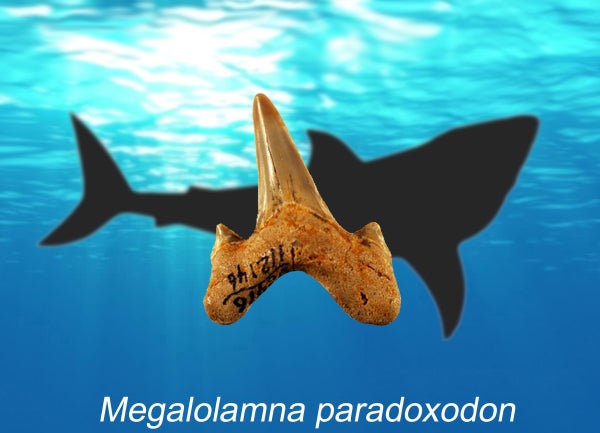This article was published in Scientific American’s former blog network and reflects the views of the author, not necessarily those of Scientific American
Prehistoric sharks can be hard to find. The bulk of their fossil record comes to us in the form of teeth scattered through localities across the globe. And as a new discovery shows, even sites that have been picked over for these dental records can still yield surprises.
About twenty million years ago, along the coasts of California, North Carolina, Peru, and Japan, there swam a shark with impressive, tri-cusped teeth. Somehow previous studies of Miocene sediment in these places missed the shark's distinctive teeth, often attributing them to pre-existing species or categories, but it's now apparent that they represent something new to science.
Paleontologist Kenshu Shimada and colleagues have named the fish Megalolamna paradoxodon - an ancient relative of the mackerel sharks that still swim the seas today. More specifically, Megalolamna was an otodontid shark - one of the megatooths related to the famous giant Carcharocles megalodon - and in working out the relationships of this family Shimada and colleagues propose a return to an old name for the world's most beloved fossil shark.
The giant, whale munching shark of b-movie and basic cable infamy has gone by several names over the years. Some paleontologists have called it Carcharodon megalodon, proposing a close relationship to today's great white. Other researchers have called it Otodus megalodon, a member of a totally extinct lineage of megatoothed sharks, while still others have favored Carcharocles megalodon. It's a big taxonomic tangle, but Shimada and coauthors propose that Otodus megalodon should be the proper genus name for the celebrity shark. This isn't a new idea, as the study itself points out, but the new analysis throws further support for a return to Otodus megalodon and a reshuffled view megatooth shark relationships. This isn't just about names. Cutting through the taxonomy and systematics of these sharks is the first step in figuring out how these impressive fish came to proliferate in the world's oceans and terrify marine mammals for millions of years.

Megalolamna sites around the world. Credit: KENSHU SHIMADA
On supporting science journalism
If you're enjoying this article, consider supporting our award-winning journalism by subscribing. By purchasing a subscription you are helping to ensure the future of impactful stories about the discoveries and ideas shaping our world today.
Fossil Facts
Name: Megalolamna paradoxodon
Meaning: Megalolamna is a reference to the shark's teeth, which are large and resemble those of today's mackerel sharks, with paradoxodon is for "its paradoxical occurrence of teeth" distant in time from its closest relatives.
Age: Miocene, about 20 million years old.
Where in the world?: California, North Carolina, Peru, and Japan.
What sort of critter?: A shark related to the extinct megatooths.
Size: The largest Megalolamna are estimated to have been over 12 feet long.
How much of the creature’s body is known?: Teeth.
Reference:
Shimada, K., Chandler, R., Tao Lam, O., Tanaka, T., Ward, D. 2016. A new elusive otodontid shark (Lamniformes: Otodontidae) from the lower Miocene, and comments on the taxonomy of otodontid genera, including the 'megatoothed' clade. Historical Biology. doi: 10.1080/08912963.2016.1236795
Previous Paleo Profiles:
The Light-Footed Lizard The Maoming Cat Knight’s Egyptian Bat The La Luna Snake The Rio do Rasto Tooth Bob Weir's Otter Egypt's Canine Beast The Vastan Mine Tapir Pangu's Wing The Dawn Megamouth The Genga Lizard The Micro Lion The Mystery Titanosaur The Echo Hunter The Lo Hueco Titan The Three-Branched Cicada The Monster of Minden The Pig-Footed Bandicoot Hayden's Rattlesnake Demon The Evasive Ostrich Seer
